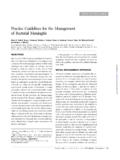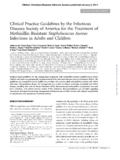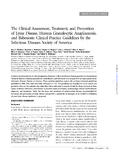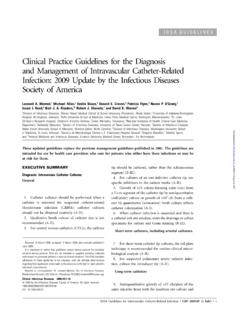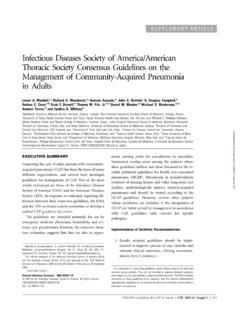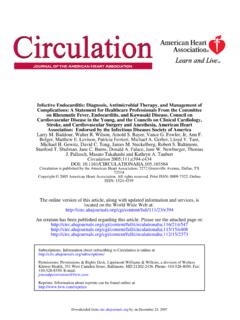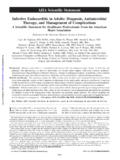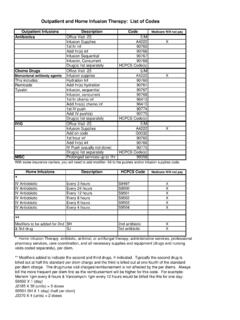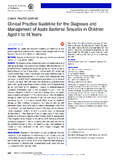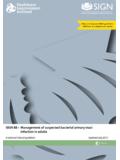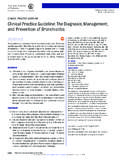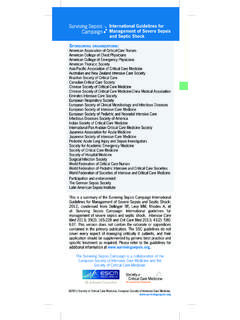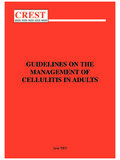Transcription of Practice Guidelines for the Management of …
1 Practice Guidelines for bacterial Meningitis CID 2004:39 (1 November) 1267 IDSA GUIDELINESP ractice Guidelines for the Managementof bacterial MeningitisAllan R. Tunkel,1 Barry J. Hartman,2 Sheldon L. Kaplan,3 Bruce A. Kaufman,4 Karen L. Roos,5W. Michael Scheld,6and Richard J. Whitley71 Drexel University College of Medicine, Philadelphia, Pennsylvania;2 Weill Cornell Medical Center, New York, New York;3 Baylor College ofMedicine, Houston, Texas;4 Medical College of Wisconsin, Milwaukee;5 Indiana University School of Medicine, Indianapolis;6 University of VirginiaSchool of Medicine, Charlottesville; and7 University of Alabama at BirminghamOBJECTIVESThe objective of these Practice Guidelines is to provideclinicians with recommendations for the diagnosis andtreatment of bacterial meningitis.
2 Patients with bacterialmeningitis are usually treated by primary care andemergency medicine physicians at the time of initialpresentation, often in consultation with infectious dis-eases specialists, neurologists, and neurosurgeons. Incontrast to many other infectious diseases, the anti-microbial therapy for bacterial meningitis is not alwaysbased on randomized, prospective, double-blind clin-ical trials, but rather on data initially obtained fromexperimental animal models of infections. A modelcommonly utilized is the experimental rabbit model,in which animals are anesthetized and placed in a ster-eotactic frame. In this procedure, the cisterna magnacan be punctured for frequent sampling of CSF andinjection of microorganisms.
3 Frequent sampling of CSFpermits measurement of leukocytes and chemical pa-rameters and quantitation of the relative penetration ofantimicrobial agents into CSF and the effects of men-ingitis on this entry parameter, the relative bactericidalefficacy (defined as the rate of bacterial eradication)within purulent CSF, and CSF pharmacodynamics. Re-sults obtained from these and other animal models haveled to clinical trials of specific agents in patients withbacterial 20 August 2004; accepted 25 August 2004; electronically published6 October or correspondence: Dr. Allan R. Tunkel, Drexel University College ofMedicine, 2900 Queen Lane, Philadelphia, PA 19129 Infectious Diseases2004; 39:1267 84 2004 by the Infectious Diseases Society of America.
4 All rights $ this guideline, we will review our recommenda-tions for the diagnosis and Management of bacterialmeningitis. Recommendation categories are shown intable 1. The guideline represents data published throughMay Management APPROACHThe initial treatment approach to the patient with sus-pected acute bacterial meningitis depends on early rec-ognition of the meningitis syndrome, rapid diagnosticevaluation, and emergent antimicrobial and adjunctivetherapy [1]. Our Management algorithm for infants andchildren is shown in figure 1, and that for adults isshown in figure 2. Once there is suspicion of acutebacterial meningitis, blood samples must be obtainedfor culture and a lumbar puncture performed imme-diately to determine whether the CSF formula is con-sistent with the clinical diagnosis.
5 In some patients, theclinician may not emergently perform the diagnosticlumbar puncture ( , secondary to the inability toobtain CSF), even when the diagnosis of bacterial men-ingitis is considered to be likely, or the clinician maybe concerned that the clinical presentation is consistentwith a CNS mass lesion or another cause of increasedintracranial pressure and will thus order a CT scan ofthe head prior to lumbar puncture. In those patientsin whom lumbar puncture is delayed or a CT scan isperformed, however, there may be a significant intervalbetween establishing the diagnosis of bacterial men-ingitis and initiating appropriate therapy. In these pa-tients, blood samples must be obtained for culture andappropriate antimicrobial and adjunctive therapy givenprior to lumbar puncture or before the patient is sentfor CT.
6 Delay in the initiation of therapy introducesthe potential for increased morbidity and mortality, if at IDSA on August 13, from 1268 CID 2004:39 (1 November) Tunkel et Diseases Society of America United States Public Health Service Grading System for ranking rec-ommendations in clinical , gradeDefinitionStrength of recommendationAGood evidence to support a recommendation for use; should always be offeredBModerate evidence to support a recommendation for use; should generally be offeredCPoor evidence to support a recommendation; optionalDModerate evidence to support a recommendation against use; should generally not be offeredEGood evidence to support a recommendation against use; should never be offeredQuality of evidenceIEvidence from 1 properly randomized, controlled trialIIEvidence from 1 well-designed clinical trial, without randomization; from cohort or case-controlled analytic studies (preferably from11 center); from multiple time-series; or fromdramatic results from uncontrolled experimentsIIIE vidence from opinions of respected authorities, based on clinical experience, descriptivestudies, or reports of expert committeesthe patient does indeed have acute bacterial meningitis.
7 Thechoice of empirical antimicrobial therapy in this situationshould be governed by the patient s age and by various con-ditions that may have predisposed the patient to the yield of CSF cultures and CSF Gram stain maybe diminished by antimicrobial therapy given prior to lumbarpuncture, pretreatment blood cultures and CSF findings ( ,elevated WBC count, diminished glucose concentration, andelevated protein concentration) will likely provide evidence foror against the diagnosis of bacterial meningitis (see What Spe-cific CSF Diagnostic Tests Should Be Used to Determine theBacterial Etiology of Meningitis?, below). Once CSF analysis isperformed, for patients with a positive CSF Gram stain result,targeted antimicrobial therapy can be initiated in adults withbacterial meningitis.
8 In children11 month of age with bacterialmeningitis, however, empirical antimicrobial therapy with van-comycin combined with either cefotaxime or ceftriaxone canbe provided pending culture results; this recommendation isbased on the concern that interpretation of the CSF Gram staindepends on the expertise of the person reading the slide; someexperts would also use this strategy in adults with bacterialmeningitis. However, a positive CSF Gram stain result maymodify this approach by the addition of another agent ( ,ampicillin for the presence of gram-positive bacilli) to these 2standard drugs. If the Gram stain result is negative, empiricalantimicrobial therapy is given, with choices of agents based onthe patient age and certain predisposing following sections will review in greater detail the evi-dence for our recommendations in these algorithms.
9 The ev-idence for these recommendations is framed in the context ofspecific questions that should be addressed in the patient withsuspected or proven bacterial Patients with Suspected bacterial Meningitis ShouldUndergo CT of the Head prior to Lumbar Puncture?Complications associated with lumbar puncture are variable,ranging from mild alterations in comfort to life-threateningbrain herniation, which may occur in the patient with elevatedintracranial pressure [2, 3]. After lumbar puncture, there isnormally a mild, transient lowering of lumbar CSF pressure asa result of removal of CSF and continued leakage of CSF fromthe opening made in the arachnoid membrane that is rapidlycommunicated throughout the subarachnoid space.
10 In patientswith intracranial, space-occupying lesions, there is a relativepressure gradient with downward displacement of the cerebrumand brainstem that can be increased by lumbar puncture,thereby precipitating brain herniation. The incidence of thiscomplication is unknown. In an older study that examined theoutcome of lumbar puncture in 129 patients with elevated in-tracranial pressure, of patients with papilledema and 12%of patients without papilledema had unfavorable outcomeswithin 48 h after the procedure [4]. When these data werecombined with a review of 418 patients with papilledema, theauthors concluded that the actual risk of serious complicationsfrom lumbar puncture in the presence of papilledema was much less than Two other studies suggested that anincidence of brain herniation was11%.
